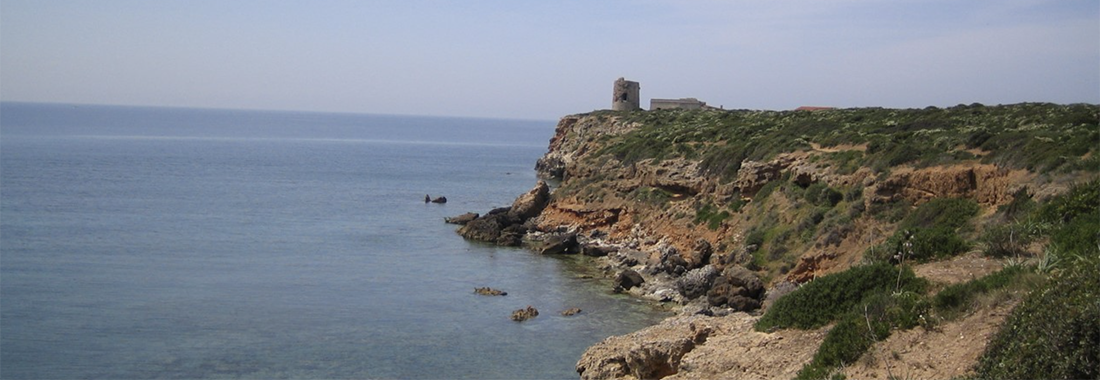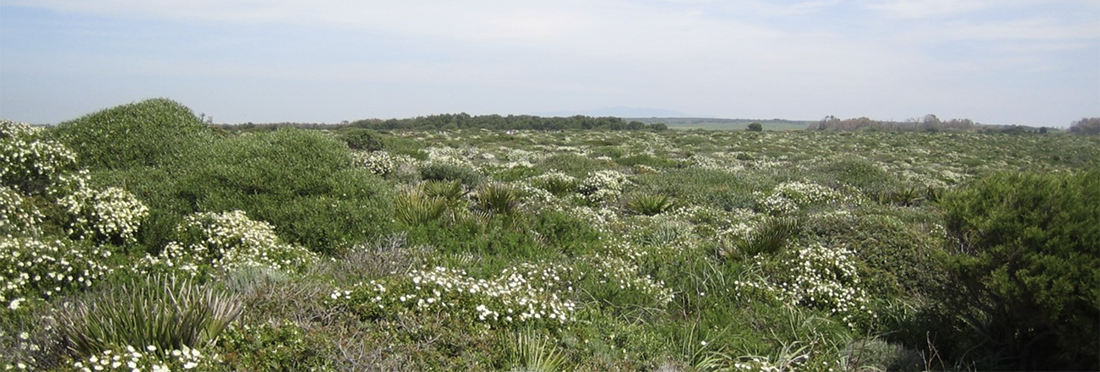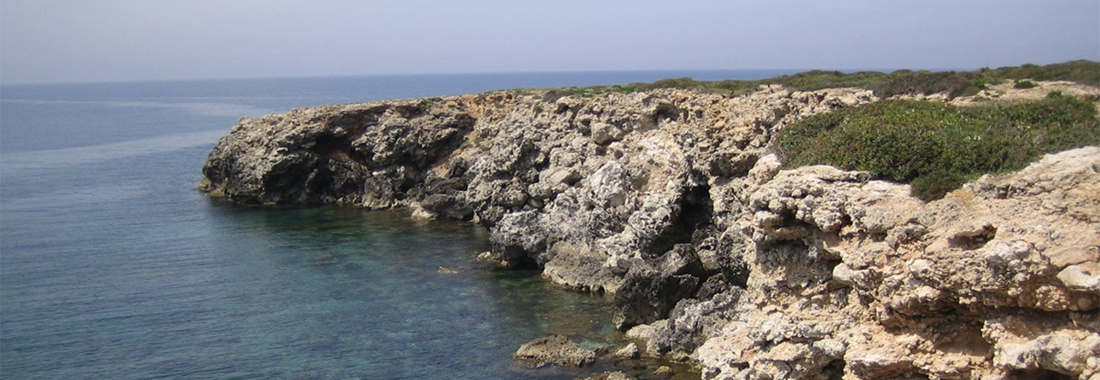It is almost as if the scrub opens only at one’s passage, and is then ready to close itself again, like water. A swarm of small fleeing birds rises from the low and compact tangle. They spread out in the clear autumn sky to settle and hide together in another point in the sea of bushes. The Mistral, which is used to beat furiously here, today is only in the shrubs, forced towards the hinterland as if it were a hairdo in a face. Then the blanket thins out, the old house of Don Efisio Carta appears before the Spanish tower, and the bright sea stretched to the horizon.
The oasis of Seu is a residual area of the Sinis Mediterranean scrub in the Gulf of Oristano. Around, the cultivated fields extend almost to the edge of the limestone coast. A naturalistic treasure that man has frequented for millennia, intensifying its presence only over the last century. "The archeology speaks for itself: the nuraghe hidden between the dunes, and the nearby well, the Punic and Roman shards that can still be found on the bottom of the Marine Protected Area. Seu is truly a jewel, both from a natural and historical point of view", says Maurizio Porcu, environmental guide of Alea, the research and environmental-tourism company that has been organizing excursions to the oasis for many years.
For much of the twentieth century Seu belonged to Don Efisio Carta, the famous owner of the Cabras pond. It was his hunting reserve, and it is in the clearing that overlooks the Spanish tower that on November 16, 1978, after a bloody brawl, Don Efisio was kidnapped by a group of bandits, according to a pattern in vogue in Sardinia in those years. He was never found. Until the mid-1990s Seu was a WWF oasis. At the death of the widow Carta, after a brief interregnum at the turn of the 2000s, when the Municipality of Cabras took possession of it, the property returned to its legitimate heirs. "The value of Seu is inestimable", confirms Massimo Marras, director of the Marine Protected Area of Sinis-Isola di Mal di Ventre. "There are numerous floral and fauna species housed in the oasis. The tortoises and the lizards, just to name a few of the best known”.
We disturb one little specimen, placidly stretched out to absorb the sun's rays on the platform that leads to the beach of Is Caogheddas, on the northern edge of the oasis. It paws quickly away. The deserted beach is a hallucination of colors. Only in the distance you can spot a solitary beach umbrella. All engrossed in himself a photographer passes by. Three cyclists look out from the dirt road. They contemplate the view, they leave. The friction of the wheels on the stones is the only sound in perfect silence. But life abounds in the oasis: "The vegetation, also consisting of Aleppo pines and eucalyptus, favors the presence and permanence of many species", explains Lara Bassu, another environmental guide of the Alea team. “The oak mouse for example, which particularly benefits from the presence of the pines. Or crocidures, which we identified thanks to the regurgitation of nocturnal birds. There is also the Suncus etruscus, the smallest mammal in Europe, which is the size of a beetle. In Seu it is possible to meet wild rabbits, Sardinian hares and foxes. The eucalyptus and the accompanying vegetation hosts the wild boars, which here find refuge from the hunters. What you saw on the platform could be a Tyrrhenian lizard, or a country lizard. In the pools of water it is possible to meet the Tyrrhenian frog, the Sardinian one, the Sardinian discoglossus and the Italian emerald toad. Of course, Seu's flagship is definitely the Moorish tortoise".
The oasis is also very rich in birdlife. The Sylviidae are omnipresent, small birds that live among the shrubs such as the Sylvia melanocephala and the Sylvia undata. But partridges, wild pigeons, owls, black starlings and kestrels also circle over the green expanse and the cliff. The night is the kingdom of owls and barn owls. Together with the island of Mal di Ventre, not far from the oasis, Seu represents an important landing place for many species of spring and autumn migrants.
“Seu must be visited on tiptoe, it is a small gem that sums up the beauty of the Sinis”, continues Lara. "During spring and autumn the hottest hours are the best. In summer the sunset, or the early morning. We of Alea have called our excursions here 'A dip in the green', which then becomes a dip in the blue...few meters away from the shore, equipped only with a mask and snorkel, it is possible to visit the wreck of the tugboat that sunk here in 1983, as well as the finds of much older shipwrecks”.

The Island made of mussels in Corru Mannu's pond began to be populated by birds
Little tern, common tern, sandwich tern, rosy gull and black-winged stilt are some of the bird species that have found a home in Corru Mannu in recent weeks. Thanks to…

Sardinian Wetlands, the best way to protect them is "to manage them"
Cagliari, 04.02.2023 – Le zone umide sono ecosistemi acquatici sempre più rilevanti, conoscerli meglio è il primo passo per tutelarli, ma non è tutto. “Serve uno strumento di gestione” per…

The II D from Terralba Institute visited the Old Tower of Marceddì as prize for Terre d'Acqua school contest 2022
Learning about the role of these precious and very important ecosystems, as well as the specificities of the large wetland area of Oristano. In recent days we have accompanied the…

Maristanis was showcased at the Ramsar COP 14 on wetlands during a side event
The 14th meeting of the Ramsar Wetlands Conference (COP14) was held in Geneva from 5 to 13 November 2022, simultaneously also in Wuhan, China. At the International Conference Center in Geneva (CICG) all…

Learning from the Maristanis's model in the ENSERES's visit exchange
Two days to study an integrated management model of marine-coastal systems, two days to strengthen ties and develop new strategies for a sustainable future of the Mediterranean. The Italian stage…

A step forward for the Maristanis project, towards the Regional Park of wetlands in Sardinia
The Municipal Council of Oristano, on the proposal of the Councilor for the Environment Maria Bonaria Zedda, has launched the participatory process and the preparatory actions necessary for the establishment…

Evaluating ecosystem services by the TESSA Methodology in Arborea
How to understand the effects on natural capitals and actual and potential state changes of individual sites important in promoting decisions to support both biodiversity conservation and ecosystem service provision?

Terre D'Acqua 2022, the winners of the school contest within the Maristanis Project
With 87 works, of which 84 in the drawing category and 3 in the comics category, the MEDSEA Foundation's Terre D’Acqua 2022 Competition ends. The school contest took place from February…

The Sardinian farms met in Arborea under the sign of Sustainability
This is the year of relaunch for the La Fiera dell’agricoltura di Arborea (Agricultural Fair of Arborea), one of the most important thematic fairs in Sardinia that promotes the productive, agro and…

Maristanis in the news: Rai and Italia 1 dedicated ample space to the Maristanis Project
The Italian press gave ample space to the Maristanis project in recent months, the Oristanese wetlands and its most important project Maristanis were told in various national and local television reports on…

The winner of the World Wetlands Day in Sardinia 2022 Contest
With a picture taken in the Oristanese lagoons representing a group of flamingos and the sentence "They come / They come back / Sometimes they stop / Like nomads /…

Over 700 visitors for the World Wetlands Day Calendar
Over 700 visitors in the World Wetlands Day collective calendar, put together by the MEDSEA Foundation, as part of the Maristanis project last February, with the aim of promoting the precious…

The World Wetlands Day 2022 in Sardinia lasts a month, the events Calendar
As every year, the World Wetlands Day on the anniversary of the RAMSAR convention (of 1971, Feb. 2nd) calls and Sardinia, in particular the Oristanese area, replies within the Maristanis project that…

World Wetlands Day in Sardinia, from 2 to 27 February join the competition #WWDSardegna on Instagram
In the occasion of the World Wetlands Day which celebrates ponds and lagoons in the world next February 2, the MEDSEA foundation launches the contest on wetlands in Sardinia with the hashtag #WWDSardegna to…

MAVA Steering Committee in Provence: Sardinia was promoted with the Maristanis project
MEDSEA foundation, which has been carrying out the Maristanis project in the Oristano area in Sardinia since 2017, attended last week the yearly meeting of the MAVA steering committee. The session took place from 16 to 17 December 2021 in Châteauneuf-le-Rouge, in the Provence-Alpes-Côte d'Azur region, and gathered together the…

Terre d'Acqua, a wetlands school competition for students in the Oristanese
On February 2, the World Wetlands Day will be celebrated once again the Oristanese wetlands region. To recall the central role of wetlands in addressing climate and environmental crisis and to raise awareness of the importance of these basins especially in this west coast side…
- 1
- 2
- 3
- 4



